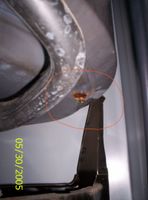Went out on a service call for an old-style Hotpoint (GE) top-loading washer. Complaint was that it leaked. When the customer called, I explained my fee structure: I charge a flat professional fee of $149 (for most repairs) which includes all trip charges, service call charges, diagnostic fees as well as the services to implement the repair, no matter what the repair or if I need to order a part and come back. Parts are extra. I also give a one hour window for arriving at the customer’s house, accept payment by cash, check or any major credit card, and guarantee my work for one year, parts and labor. She was fine with this and just wanted her washer fixed ASAP. I got out the same day.
Upon arrival, I pulled the washer out from the wall, removed the back panel and added some water to the tub in order to locate the leak in accordance with Samurai’s 14th Law of Appliance Repair, “All leaks are visual.”
The source of the leak soon became evident. It was a rust hole in the outer tub of the washer, as shown below. Click the picture for a larger view.

Rust hole in an old-style GE/Hotpoint washer tub.
I advised the customer that it was in her best interest to buy a new washer. Obviously, I couldn’t charge $149 for just diagnosing the problem and determining that it would be in the customer’s best interest to purchase a new washer. Since I was effectively condemning this washer, I only charged her a $65 fee for diagnosing the problem. I so rarely condemn appliances while at the customer’s home that I almost never discuss that possibility with them on the phone while setting up the service call. Ain’t I special? I love me!
Now that most of you are no longer reading this post, I’ll go ahead and share with you my reasoning for charging the way I do. I used to charge using the Blue Book flat rate guide. I would charge a $69 diagnostic fee for which I would schedule an appointment with the customer to diagnose their appliance and give them a quote for the repair. The repair fee would come out of the Blue Book flat rate guide. If the customer declined the repair, they would only owe the $69 diagnostic fee.
The problem with this fee structure is that it creates an unrealistically low price expectation in the customer’s mind for what the repair will cost. Inevitably, after troubleshooting the appliance and quoting the repair cost, I would get asked, “How much is a new one?” I got asked this question so frequently that I wrote an article about it that I would hand out to customers. Worse yet, about half the time, the customer would decline the repair, pay the $69 fee, and be left feeling soiled, as if I was trying to pull a fast one, and I walked out with $69 for “just looking at it.”
Funk that noise!
Here’s a fun fact to know and tell: the average repair price under this new fee structure is actually less than what it was using the flat rate book! But all some people hear on the phone is $149 and they’re off searching for someone who’ll tell them something misleading because, the fact is, most people need to be lied to when it comes to paying what it really costs for in-home service. But those folks are not my customers. The nice thing about my new fee structure is that it automatically selects people who are my customers: they have a realistic expectation of what it will cost to get it fixed; they value their time and so appreciate that I schedule one-hour windows for arriving at their home; and they like that I stand behind my work for one full year, parts and labor.
So, I decided instead of letting people know how much it’s gonna cost to repair their low-brow, cheesy appliance after I’ve already wasted a chunk of my life rolling around on their filthy kitchen floor or in their nasty laundry room, why not give ’em a good idea right up front, on the phone? So that’s what I do now and life is mucho better. I schedule far fewer service calls but end up grossing about the same amount of money and my job average has doubled from under $100/job to almost $200/job. But, here’s the kicker: fewer service calls means lower variable costs and a correspondingly healthier bottom line. And, most importantly, it means more time off for the really important things in life, like hiking.


Is it possible an epoxy patch would work here, for the truly poverty-stricken?
Properly applied, an epoxy patch would probably work very well. But the kicker is getting the patch on there correctly. You’d have to remove the inner basket and grind out all the rust or the metal tub will continue to rot out even with epoxy over it. Tricky operation.
Now, if the tub were plastic, I wouldn’t hesitate to use an epoxy patch, knowing that it could be easily and properly applied and that such a patch will actually be stronger than the rest of the tub.